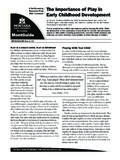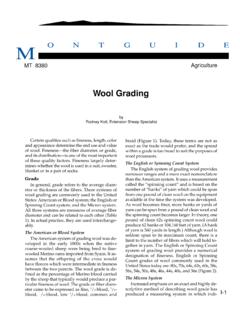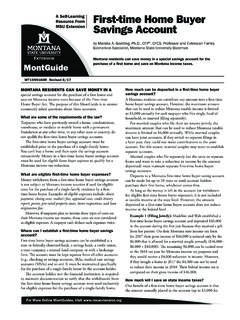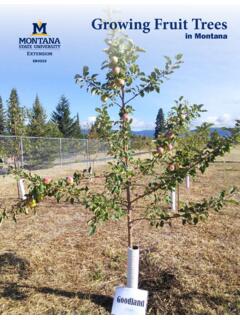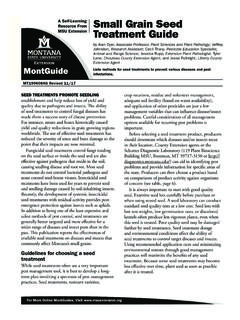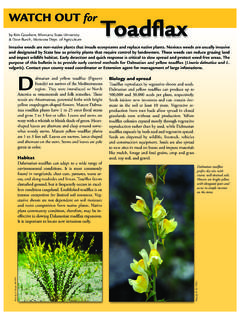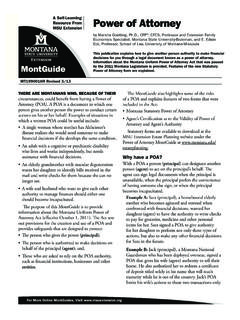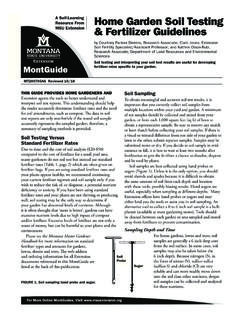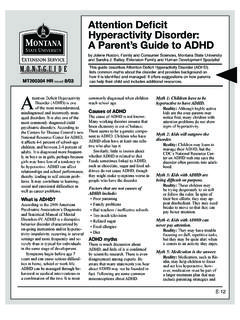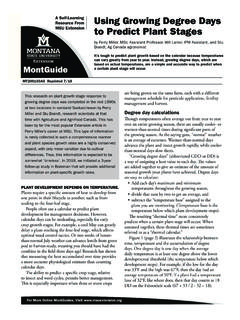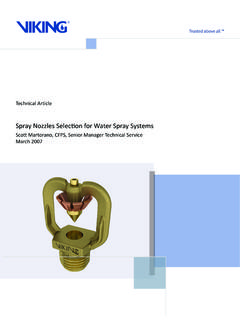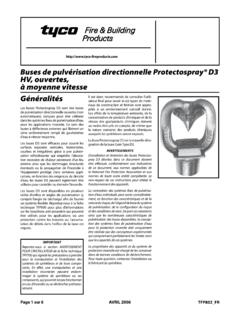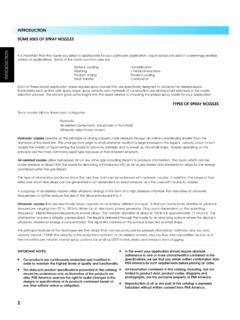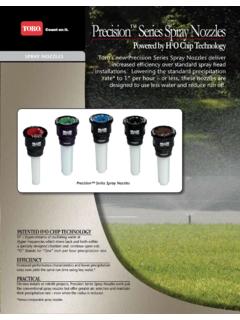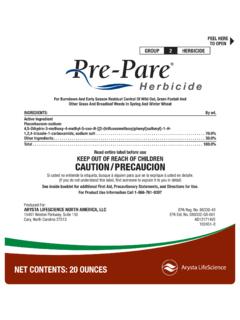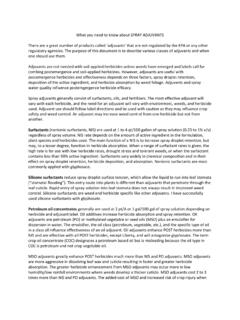Transcription of Calibrating Ground Sprayers Using Shortcut Methods
1 Calibrating Ground Sprayers Using Shortcut Methods by Cecil Tharp, Pesticide Education Specialist, MSU Department of Animal and Range Sciences Applicators often find Calibrating Ground Sprayers challenging. Short cut Methods to calibration were developed to remedy this situation. This publication was created as an aid to understanding the variety of short cut MontGuide Methods that are available for Ground spraying equipment MT200915AG Revised 12/16. PESTICIDE APPLICATION EQUIPMENT SHOULD Pre-Calibration Using the 5940 Method be calibrated every field season. Short cut calibration Though the 5940 method contains some math, it aids Methods were developed to minimize the math required applicators in refining their field speed and selecting for calibration. These simple to use Methods are specific to appropriate nozzles prior to actual field calibration.
2 The the spray equipment they may be used on. This guide has 5940 method takes advantage of many factors which often gathered many short cut Methods into one short publication are already known by the applicator. This method should to minimize confusion. Simply select the Ground application serve as a guide only, with a follow-up field calibration to equipment to be calibrated and follow the instructions. assess any equipment inconsistencies. Prior to the calibration of any pesticide application 1. Selecting appropriate nozzles (GPA, speed and nozzle equipment, applicators should follow a pre-calibration spacing known). One of the most critical steps to the checklist. This includes knowing the field speed, selecting calibration process is the selection of appropriate nozzles. If spray pressure, and selecting appropriate nozzles for the the field speed, GPA, and nozzle spacing are known, nozzle application.
3 Field speed is often preset between safety and flow rate (gallons per minute) can be determined with the maximizing Ground covered, while spray pressures are often 5940 equation. An applicator may purchase the appropriate recommended on the pesticide product labels. For more nozzles once nozzle flow rate is known. information on determining field speed or selecting spray pressure refer to MSU Extension MontGuide Calibrating GPA x MPH x W. Pesticide Application Equipment (MT200914AG). A = GALLONS PER MINUTE. 5940 (flow rate of nozzles). stopwatch, measuring tape, flags, measuring container, pencil and paper are required for calibration. Example: The product label recommends an output of 20. GPA, the width of the nozzles on the spray boom is 18. inches and your field speed is 4 MPH: (20 x 4 x 18) 5,940 = 1,440 5,940 = Gallons per minute Flow rate 5940 Abbreviations MPH = constant GPA = Gallons per acre*.
4 MPH = Field speed in miles per hour GPM = Gallons per minute (nozzle flow rate). W = Width between nozzles in inches, or width of a broadjet swath in inches. *Keep in mind that recommended GPA is often given on the product label while nozzle spacing is often preset. Simply measure in inches your nozzle spacing or spray swath width. Nozzle flow rate can be obtained by simply collecting liquid from one nozzle for one minute (all nozzles should be assessed for uniformity on spray booms). For More Online MontGuides, Visit 2. Assessing ideal field speed to obtain a given GPA 1. Measure the volume of water from each nozzle for one (GPA, nozzle flow rate and nozzle spacing known). It minute at a constant pressure and/or RPM. may be necessary to know the ideal field speed when the 2. Determine average nozzle output.
5 Output of the sprayer (GPA), nozzle flow rate, and nozzle 3. Determine the acceptable error range (usually within 10. spacing is known. Field speed may be adjusted to fine-tune percent). the output of the sprayer. Remember, ideal GPA is given on the product label and a sprayer may often have nozzles 4. Replace or clean nozzles outside of range and retest. installed at a given spacing. Example: You have a five nozzle boom and have collected water from each nozzle for one minute. You note the GPM x 5940 following outputs: = FIELD SPEED. GPA x W (miles per hour). Nozzle = 1 2 3 4 5. Example: The product label recommends an output of 10 Ounces = 30 29 30 24 30. GPA, the width of the nozzles on the spray boom is 24 Total = 143 ounces inches and the nozzle flow rate is gallons per minute: 143 5 = oz.
6 Average Nozzle Output ( x 5,940) (10 x 24) = 1,188 240 Find your 10 percent range: x = oz to = miles per hour Field Speed add and subtract from the average. Your range is to ounces. Replace or clean nozzle 4 and retest. 3. Assessing the spray output of your boom when speed, nozzle spacing, nozzle flow rate and width between nozzles Assessing GPA of your Boom Sprayer To determine the are known. It may be beneficial to know the sprayer output output of your boom sprayer use the 128th acre method. prior to changing the spray equipment set up. It may not be The 128th acre Shortcut method involves determining the necessary to adjust anything from the current configuration. length of time necessary to drive a preset distance and then measuring the amount of liquid applied during that time. GPM x 5940 With this short cut, one ounce of discharge per nozzle equals = GPA (gallons per acre).
7 MPH x W a one gallon per acre output. Preset course lengths must be obtained by comparing nozzle spacing with Table 1. Example: A boom has a nozzle spacing of 18 inches, nozzle flow rate of .2 gallons per minute, and a field spray speed 1. Define course length (Example: 20 inch nozzle spacing of 4 MPH: = 204 feet course length). 2. Time how long it takes to travel the course at a constant ( x 5940) (4 x 18) = 1,188 72 = GPA. spray speed. Conduct the test two to three times and Always double check the actual sprayer output (GPA) calculate the average time required (Example: Traveled in the field after Using the 5940 equations. The 5940 204 feet in 30 seconds). equations do not guarantee a given GPA in the field due 3. Collect liquid at a constant pressure and/or RPM from to inconsistencies such as non-uniformity of nozzles or one nozzle for that amount of time (Example: Collected equipment failure.)
8 This is simply a tool to get closer to the 30 ounces from 1 nozzle in 30 seconds). ideal spray output. 4. Determine GPA by converting ounces of liquid Short Cut Method for Calibrating Output collected into Gallons Per Acre (Example: 30 ounces collected = 30 GPA). Boom Sprayers TABLE 1. Defined course lengths. Testing Uniformity of Nozzles Accurate calibration of boom Sprayers is a combination of assessing uniform nozzle Nozzle Spacing or Course Length flow, determining sprayer output rate, and tank mixing. Band Width (inches) (feet). Checking all nozzles on spray booms for uniformity is 18 227. always the first step. 20 204. Nozzles may be worn or damaged, preventing uniform 30 136. spray coverage. All nozzles across a boom must be applying 36 113. the same amount of liquid within a certain error range 40 102.
9 (usually 10 percent on either side of the average for all If you have another nozzle width use this formula to nozzles). Clean and/or replace any nozzles that fall outside determine course length: 340 nozzle spacing in feet. of the error range. When assessing nozzle uniformity, follow these steps: 2. Handheld Sprayers Example: If the sprayer is calibrated at 30 GPA and holds The 128th acre Shortcut method can also be used for 500 gallons, acres can be sprayed (500 30 = Calibrating the output of handheld Sprayers . With this acres). method one ounce of discharge equals a one gallon per acre output. Determine the Amount of Spray Solution Measure an 18 x 18 foot area which represents a To determine the amount of spray solution needed in a 128th acre. Then time how long it takes to spray this area spray tank, simply follow this formula: with water at a constant speed and pressure (Example: 20.)
10 Seconds to hand spray 128th acre). Repeat two to three times GPA x Sprayed Acres = Spray Mix Needed and calculate the average time required. Spray water into a measuring container for that amount of time. The number Example: If your sprayer was calibrated at 30 GPA and you of ounces collected can be converted directly to gallons needed to spray 15 acres you would need 450 gallons of per acre (Example: Collected 40 ounces from nozzle in 20 spray mixture (30 x 15 = 450 gallons). seconds which equals an output of 40 GPA). Determine Amount of Product to Add to the Tank Broadjet Sprayers When Acres to Spray is Known The 128th acre method is often difficult to use on broadjet The amount of pesticide product to deliver over a given area application equipment due to the limited course length. is stated on the product label.
